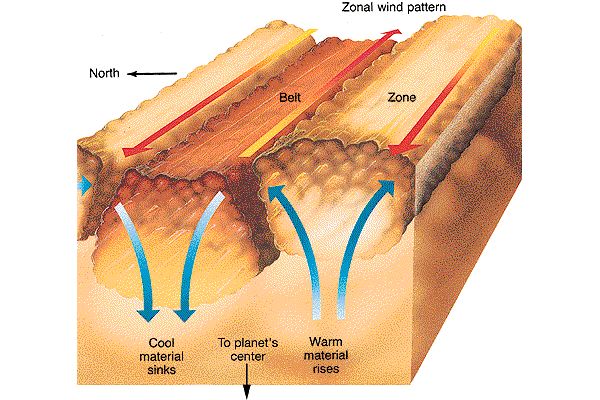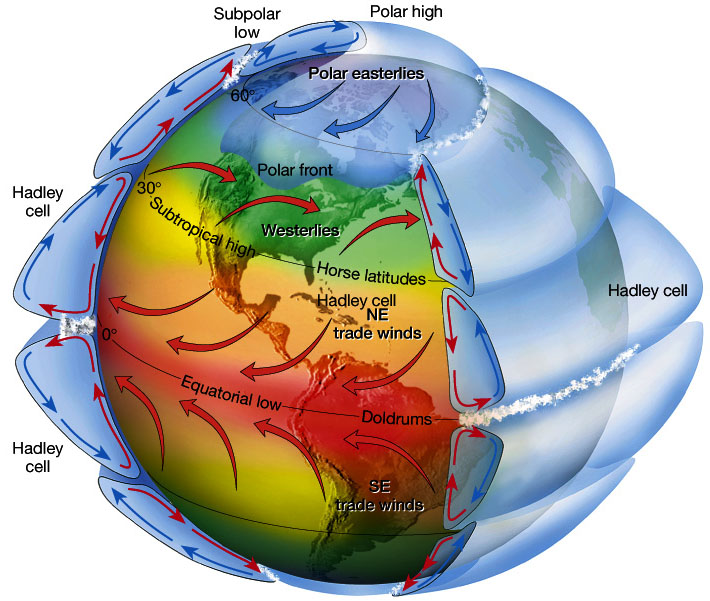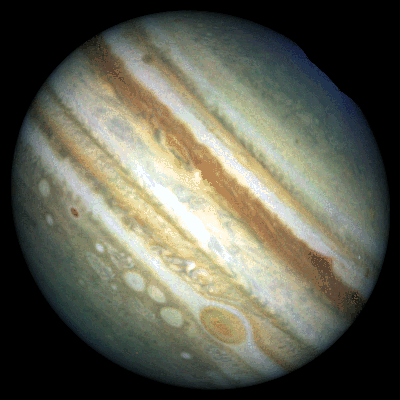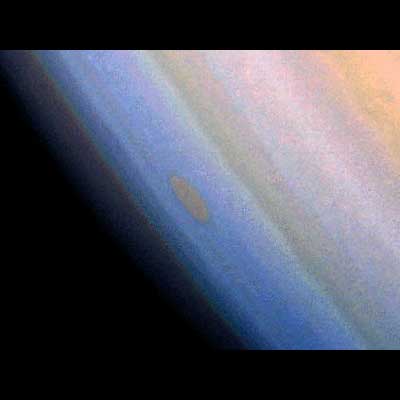Vertical Structure
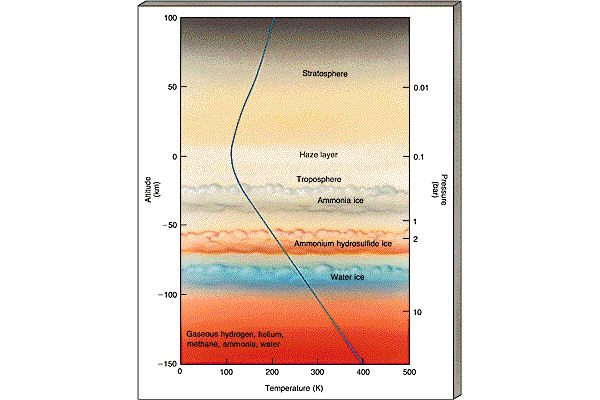
|
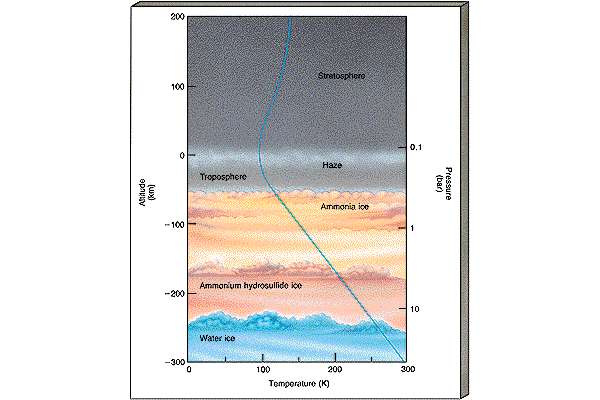
|
Jupiter (left) and Saturn (right)
are gaseous and so where their atmospheres begin as
well as end depends upon arbitrary definitions. The atmospheres of
Jupiter and Saturn contain tropospheres (the "weather" forming
layer) and stratospheres.
The brightly colored stripes seen on the surface of Jupiter and Saturn
are different cloud layers
(ammonia
ice, ammonium hydrosulfide
, and
water ice), which sit just below a layer of haze (a layer
created by photochemical reactions similar to those which form
smog on the Earth). The haze layer lies
just above the troposphere.
Jupiter's clouds are arranged in three main layers;
the first lies 40 or kilometers below the haze and is composed of
wispy whitish ammonia ice clouds. Below the
the ammonia ice clouds lies the warmer ammonium hydrosulfide clouds (tawny or
brownish-yellow in color), and
the deepest warmest layer of clouds, the water ice clouds (are bluish)
Why the stripes are the particular
colors they are is not clear however; the color depends upon chemistry
which we do not quite have a handle on.
Note that the atmosphere of Saturn is much thicker (spread-out) than is
Jupiter's -- Saturn goes a depth of 300 km compared to Jupiter that goes to
a depth of 150 km. It is this spreading-out of the atmosphere of
Saturn that gives it its more muted coloration.
ATMOSPHERIC MOTIONS
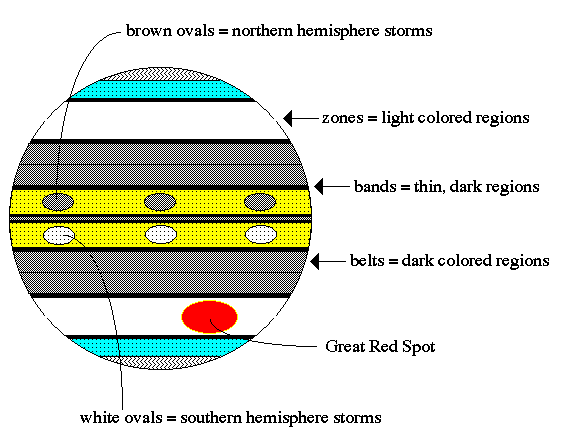

The light colored stripes are known as zones
while the darker colored
stripes are known as belts. The
thin narrow dark stripes which
separate the regions are known as bands
. Also, we cannot forget
Jupiter's Great Red Spot,
which is a large and stable (Robert Hooke discovered the Great Red Spot
in the mid 1600s) atmospheric disturbance that exhibits anti-cyclonic motion
(see below). A century ago, the Great Red Spot was around 40,000 kilometers
across; today it is roughly half that size. Other oval features are also seen;
brown ovals in the northern hemisphere and
white ovals in the southern
hemisphere.
The interesting patterns and motions seen in the Jovian atmospheres are
driven primarily by the large heat flow through the atmospheres (due to
flow from the interior and heating by the Sun) and by the
rapid rotation of Jupiter and Saturn.
Comment
Both Jupiter and Saturn rotate with
periods on the order of 10 hours, the Earth has a rotational period of 24
hours. The difference is more extreme than these numbers imply however.
Why?
Recall that a person standing on the equator of the Earth is carried
along by the rotation of the Earth with a speed of
speed = circumference/day = 25,000 mi/24 hr = 1,000 mi per hr
On Jupiter, a person standing at the equator is carried along at a speed of
speed = circumference/"day" = 250,000 mi/10 hr = 25,000 mi per hr
The centrifugal force
(and other "rotational" forces) play important roles on the Jovian planets.
Let's consider some effects of the heat flow coupled to the
rotation in the atmospheres of Jupiter and Saturn.
Jupiter (left) and Saturn (right) are gaseous and so where their atmospheres begin as well as end depends upon arbitrary definitions. The atmospheres of Jupiter and Saturn contain tropospheres (the "weather" forming layer) and stratospheres. The brightly colored stripes seen on the surface of Jupiter and Saturn are different cloud layers (ammonia ice, ammonium hydrosulfide , and water ice), which sit just below a layer of haze (a layer created by photochemical reactions similar to those which form smog on the Earth). The haze layer lies just above the troposphere.
Jupiter's clouds are arranged in three main layers; the first lies 40 or kilometers below the haze and is composed of wispy whitish ammonia ice clouds. Below the the ammonia ice clouds lies the warmer ammonium hydrosulfide clouds (tawny or brownish-yellow in color), and the deepest warmest layer of clouds, the water ice clouds (are bluish)
Why the stripes are the particular colors they are is not clear however; the color depends upon chemistry which we do not quite have a handle on.
Note that the atmosphere of Saturn is much thicker (spread-out) than is Jupiter's -- Saturn goes a depth of 300 km compared to Jupiter that goes to a depth of 150 km. It is this spreading-out of the atmosphere of Saturn that gives it its more muted coloration.

|

|
The light colored stripes are known as zones while the darker colored stripes are known as belts. The thin narrow dark stripes which separate the regions are known as bands . Also, we cannot forget Jupiter's Great Red Spot, which is a large and stable (Robert Hooke discovered the Great Red Spot in the mid 1600s) atmospheric disturbance that exhibits anti-cyclonic motion (see below). A century ago, the Great Red Spot was around 40,000 kilometers across; today it is roughly half that size. Other oval features are also seen; brown ovals in the northern hemisphere and white ovals in the southern hemisphere.
The interesting patterns and motions seen in the Jovian atmospheres are driven primarily by the large heat flow through the atmospheres (due to flow from the interior and heating by the Sun) and by the rapid rotation of Jupiter and Saturn.
Comment
-
Both Jupiter and Saturn rotate with
periods on the order of 10 hours, the Earth has a rotational period of 24
hours. The difference is more extreme than these numbers imply however.
Why?
Recall that a person standing on the equator of the Earth is carried along by the rotation of the Earth with a speed of
On Jupiter, a person standing at the equator is carried along at a speed of
The centrifugal force (and other "rotational" forces) play important roles on the Jovian planets.
